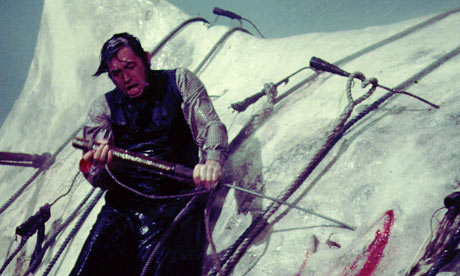 Or, a review of Moby Dick
Or, a review of Moby Dickby Courtney Hilden
Moby Dick is the novel that most high schoolers loathe to read, especially since it takes frequent, chapter-long breaks to describe sperm whales, to the point where academics have wondered if there was something homoerotic in Melville's descriptions. Here, the novel has been turned in, rather faithfully, to a movie.
For those of you not familiar with the novel, the story follows Ishmael, the narrator, on his first trip on a whaling vessel named the Pequod out of New Bedford. Ahab, the ship's captain, is obsessed with annihilating the title whale. Ahab had previously lost his leg to the creature and will have his revenge even if it means destroying the ship and himself. As Ahab's quest continues, his insanity spreads to the rest of the crew, who become increasingly crazy like Marlowe in Heart of Darkness.
The land and day scenery in the film is phenomenal and beautiful, loving shot by someone who clearly loves Sargent-like views of nature. Much of the rest of the film is shot like a horror film, with dark shadows closing in the actors and flashes of lightning dramatically illuminating the anti-hero, Captain Ahab. There's something terrible and comic about the mariner church at the beginning of the film. The preacher actually climbs into a mini-ship turned pulpit, even bringing up the ladder. The colors chosen for this movie are beautiful and spot-on considering the subject matter.
Orson Welles gives a perfect, go-for-broke performance in this film as the preacher. He's a chameleon, disappearing behind the massive beard and blending into the role. Gregory Peck, thirty-eight years old at the time of the movie, seems far too young for the role of Captain Ahab. I was struck by how baby-faced he was, and it distracted me from much of his performance. He has one expression the entire movie, a foul snear, making Ahab even more one-note than he was in the novel. Near the climax of the movie, his depiction slides into camp, to the point where he's not so much playing Ahab but a cartoon of Ahab. Unfortunately, Ahab is such an essential part of this film that Peck's performance ruins what would otherwise be a splendid movie.
Unsurprisingly, the movie depicts Queequeeq, the Other of the novel, as a stereotype of every "strange" aspect of native culture. He has his hair in a ponytail and is decorated in designs painted on with black Indian ink. His English is bad; he's uneducated. He's just a cannibal; no attempt is made to explain that his culture may not simply be savage.
 He simply is a savage. Queequeeq is even a magical Other, since he uses magic to predict the oncoming slaughter and then gives up living. It's too bad but not very shocking that a movie made in the 1950s would have an simplistic portrayal of the one character of color.
He simply is a savage. Queequeeq is even a magical Other, since he uses magic to predict the oncoming slaughter and then gives up living. It's too bad but not very shocking that a movie made in the 1950s would have an simplistic portrayal of the one character of color.The film's soundtrack is filled with the delightfully baroque music older movies loved to employ. In some movies it's distracting, but here it manages to just be another part of the story, as incidental music ideally should be.
It's hard to believe the screenplay was written by Ray Bradbury, the science fiction writer, buhe film is in many ways a success, since it manages to show all the many aspects of the original novel. It's a juggling job that a lesser cast and crew would have never pulled off. Moby Dick as a movie is just like the novel: an epic achievement in American storytelling.
No comments:
Post a Comment